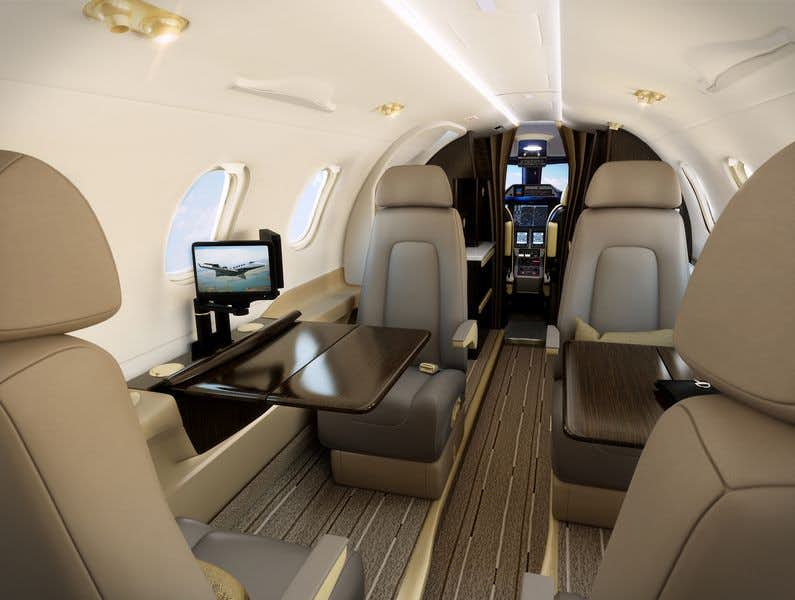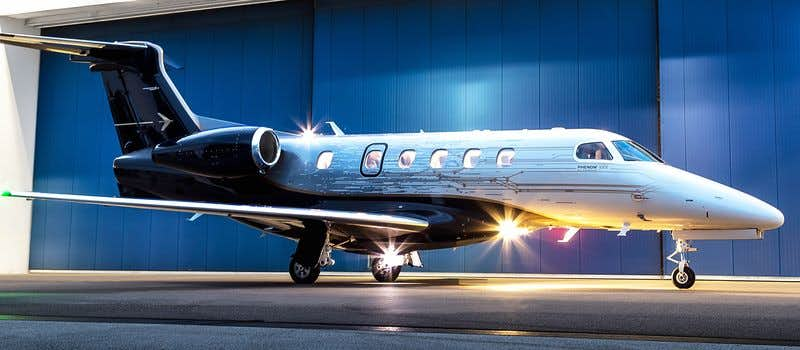
(Editor’s Update Sept. 12, 2019: Netjets, Magellan Jets and Alliance Aviation have added Phenom 300 jet card programs since this article was published.)
The Phenom 300 and now the 300E have proven their value at the cash register, leading the competitive light cabin private jet market for more than half a decade. In the jet card segment, both JetSuite and Airshare (formerly Executive AirShare) have both made a bet on the Phenom 300 in place of other similar aircraft.
The Phenom 300/300E at a maximum takeoff weight of 17,968 is on the large side of light jets (the cutoff to midsize cabins is 21,000 pounds). It has a cabin height of 4.92 feet, second only to the newly minted Pilatus PC-24 and one of the widest cabins. With one of the longest cabins (17.17 feet), it also has the most spacious cabin (324 cubic feet) second to only the PC-24, which still has only a handful of aircraft in service compared to about 500 for the P300.
In terms of range, you can fly 1,811 nautical miles (nm) full or 2,077 nm with four passengers, according to Conklin & de Decker Associates, Inc. Teterboro to Salt Lake City at 1,724 nm is an example while a flight like Charlotte, North Carolina to Aspen, Colorado at 1,258 nm is well in its range both east and westbound. In terms of speed, the Phenom 300 has a maximum cruise speed of 511 miles per hour and long-range cruise speed of 441 miles per hour, faster than the PC-24, Cessna Citation Encore, Ultra and CJ3 and HondaJet and within 10 miles per hour of the also popular Beechcraft Hawker 400XP (518 mph) although there are others faster, such as the Dassault Falcon 10/100 that can reach up to 564 mph.
In terms of baggage capacity, with 85 cubic feet (cu. ft.) the P300 series comes in slightly behind the PC-24 at 90 cu. ft. and nearly double what you will find in many other light jets that are often used in the jet card market. For example, the Hawker 400XP is just 56 cubic feet. Excluding the lavatory seat – which is fully enclosed, most configurations are for seven or eight passengers, although three to five is probably the most comfortable for flights over two hours.
So while with some 500 Phenom 300s delivered, there’s a chance you will get one if you buy a light jet card program, one nice feature of today’s card offerings is you can buy a specific aircraft type much like full ownership or fractional shares and leases. List price to buy a new one is just under $10 million.
So if you don’t want to buy a share (Airshare, Flexjet and NetJets all have fractional share and lease programs), you can also get your Phenom 300 in jet card size. NetJets has said it plans to add the aircraft to its jet card program, maybe as early as next year, while Flexjet already offers it via dedicated 25 and 50-hour cards. Airshare which serves Midwest markets in Kansas, Missouri, Oklahoma, Texas and now Colorado, with plans to expand to Chicago next year, offers the P300 starting at 10 days per year – yes – it uses a formula that combines days and hours. Meanwhile, GrandView Aviation also offers a Phenom 300 jet card program on its owned fleet with fixed rates based on travel to and from its bases at Martin State Airport outside Baltimore, Maryland, and Austin, Texas.
Dallas-based JetSuite offers the Phenom 300 and recently went to a national by the hour program priced at $6,400 per hour, excluding the 7.5% Federal Excise Tax while OneFlight also offers a fixed rate, guaranteed availability program that enables members to select the P300 based on buying at least 25 hours. Nicholas Air offers the P300 starting at just 15 hours. We have also heard from one other prominent card provider that plans to roll out a dedicated P300 card.
While there are many reasons to like the Phenom, one reason not always mentioned is that it has only been in production for about a decade, meaning if you prefer newer aircraft, the P300 fits that bill as well.




